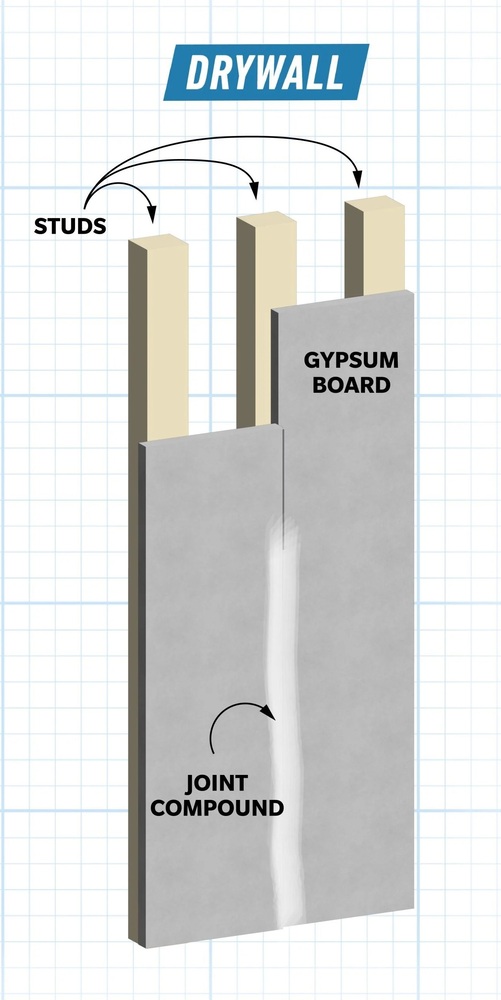Comparison between drywall and traditional gypsum wall
Drywall introduction
Drywall, also known as plasterboard, wallboard, gypsum board, or sheetrock, is a widely used construction material for creating interior walls and ceilings. Here are the key points about drywall:


Composition
Gypsum Core: Drywall consists of a layer of gypsum plaster, which is calcium sulfate dihydrate (CaSO₄·2H₂O), pressed between two thick sheets of paper or fiberglass mats.
Additives: The gypsum plaster is mixed with various additives such as fibers (paper or glass), plasticizers, foaming agents, and other substances to enhance properties like fire resistance, mildew resistance, and sound insulation.
Types of Drywall
Standard Drywall: Ideal for general construction needs.
Mould-Resistant Drywall: Best for areas prone to moisture, such as bathrooms and kitchens.
Fire-Resistant Drywall: Contains fibers that help slow the spread of fire, suitable for high-risk areas.
Soundproof Drywall: Enhanced with sound-dampening materials, perfect for creating quiet environments.
Applications
Walls and Ceilings: Drywall is primarily used for creating smooth finishes for walls and ceilings in residential, commercial, and industrial buildings.
Architectural Enhancements: It can be used to craft decorative features like archways, ceiling coffers, and custom shelving.
Room Partitions: Drywall is easy to use for partitioning rooms without heavy construction.
Challenges
Moisture Sensitivity: Standard drywall is vulnerable to moisture, which can lead to mold growth and structural damage.
Overall, drywall has revolutionized the construction industry with its ease of installation, cost-effectiveness, and versatility, making it a preferred choice for builders and contractors.
Traditional gypsum wall
Traditional gypsum wall refers to the use of gypsum in its various forms to create wall finishes, particularly before the widespread adoption of modern drywall. Historically, gypsum was used to create a plaster finish. This involved mixing gypsum powder (calcium sulfate dihydrate) with water to form a paste, which was then applied to walls and ceilings in multiple layers. This process was labor-intensive and required skilled craftsmen.

Comparison
Traditional gypsum walls and drywall have distinct differences in terms of their construction, properties, and applications. Here are the key comparisons:
- Construction Method
Traditional Gypsum Walls: These walls are constructed using a plastering process where a mixture of gypsum, lime, sand, and water is applied in multiple layers to a surface, typically between wooden or metal laths. This process is labor-intensive and requires skilled craftsmanship.
Drywall: Drywall is a manufactured product made by sandwiching gypsum plaster between two thick paper panels and kiln-drying it. This results in a pre-fabricated panel that can be easily installed.
- Installation
Traditional Gypsum Walls: The installation process is time-consuming and involves multiple steps, including preparing the surface, applying multiple layers of plaster, and allowing each layer to dry before applying the next. This requires significant labor and time.
Drywall: Drywall is much quicker to install. The panels can be easily cut to size, and the installation process involves fewer steps, making it more efficient and less labor-intensive.
- Properties
Traditional Gypsum Walls: These walls offer exceptional durability, soundproofing, and fire resistance. However, they are more susceptible to cracking over time, especially in areas prone to structural movement or settling.
Drywall: Drywall is also fire-resistant due to the gypsum content, but it can be further enhanced with additives. It is less prone to cracking and offers good sound insulation. However, it may not match the durability and soundproofing of traditional plaster.
- Cost and Labor
Traditional Gypsum Walls: The traditional method is generally more expensive due to the labor-intensive process and the need for skilled craftsmen.
Drywall: Drywall is more cost-effective, both in terms of material and labor costs. It is widely available and can be installed by contractors with basic carpentry skills.
- Design Flexibility
Traditional Gypsum Walls: While traditional plaster offers a variety of finishes, it may have limitations in accommodating certain design preferences. Achieving intricate designs requires highly skilled and specialized techniques.
Drywall: Drywall provides a smooth surface that allows for various finishing options, including painting, wallpapering, or adding texture. It offers greater design flexibility and ease of achieving different aesthetic preferences.
- Moisture Resistance
Traditional Gypsum Walls: Traditional plaster can be vulnerable to high humidity and moisture, which can lead to damage over time.
Drywall: Drywall, especially types like greenboard, is designed to be more resistant to moisture. However, prolonged water exposure can still cause damage.
- Fire Resistance
Traditional Gypsum Walls: These walls have inherent fire resistance due to the water content in the gypsum, which helps to resist high temperatures.
Drywall: Drywall also has fire-resistant properties, which can be enhanced with specialized types such as Type X drywall.
conclusion
Traditional Gypsum Walls are known for their durability, soundproofing, and fire resistance but are more labor-intensive and expensive to install.
Drywall is a faster, more cost-effective option with good fire resistance and sound insulation properties, making it a popular choice for modern construction projects.

